
The Kuomintang (KMT), also referred to as the Guomindang (GMD), the Nationalist Party of China (NPC) the Chinese Nationalist Party (CNP), or the National People's Party of China, is a major political party in the Republic of China, initially based on the Chinese mainland and then in Taiwan since 1949. The KMT is a centre-right to right-wing party and the largest in the Pan-Blue Coalition, one of the two main political groups in Taiwan. Its primary rival is the Democratic Progressive Party (DPP), the largest party in the Pan-Green Coalition. As of 2024, the KMT is the largest single party in the Legislative Yuan. The current chairman is Eric Chu.

The Taiwan independence movement is a political movement which advocates the formal declaration of an independent and sovereign Taiwanese state, as opposed to Chinese unification or the status quo in Cross-Strait relations.

The Chinese Civil War was fought between the Kuomintang-led government of the Republic of China and the forces of the Chinese Communist Party (CCP), with armed conflict continuing intermittently from 1 August 1927 until Communist victory resulted in their total control over mainland China on 7 December 1949.
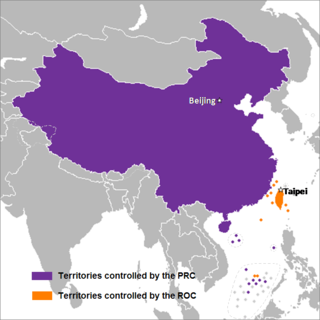
Chinese unification, also known as Cross-Strait unification or Chinese reunification, is the potential unification of territories currently controlled, or claimed, by the People's Republic of China and the Republic of China ("Taiwan") under one political entity, possibly the formation of a political union between the two republics. Together with full Taiwan independence, unification is one of the main proposals to address questions on the political status of Taiwan, which is a central focus of Cross-Strait relations.

The Pan-Blue coalition, Pan-Blue force or Pan-Blue groups is a political coalition in the Republic of China (Taiwan) consisting of the Kuomintang (KMT), People First Party (PFP), New Party (CNP), Non-Partisan Solidarity Union (NPSU), and Young China Party (YCP). The name comes from the party color of the Kuomintang.
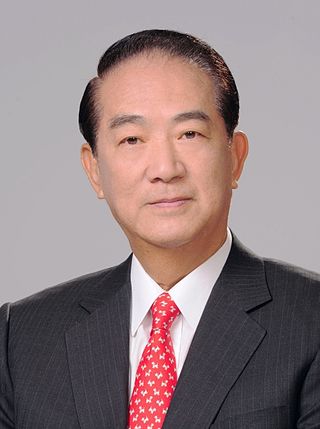
James Soong Chu-yu is a Taiwanese politician who is the founder and chairman of the People First Party. Soong was the first and only elected governor of Taiwan Province from 1994 and 1998. He was a candidate in the 2000 presidential election, which he lost to Chen Shui-bian of the Democratic Progressive Party (DPP).

The Constitution of the Republic of China is the fifth and current constitution of the Republic of China (ROC), ratified by the Kuomintang during the Constituent National Assembly session on 25 December 1946, in Nanking, and adopted on 25 December 1947. The constitution, along with its Additional Articles, remains effective in ROC-controlled territories.
The history of the Republic of China began in 1912 with the end of the Qing dynasty, when the Xinhai Revolution and the formation of the Republic of China put an end to 2,000 years of imperial rule. The Republic experienced many trials and tribulations after its founding which included being dominated by elements as disparate as warlord generals and foreign powers.

The Revolutionary Committee of the Chinese Kuomintang, commonly abbreviated in Chinese as Minge (民革), is one of the eight minor political parties in the People's Republic of China under the direction of the Chinese Communist Party.
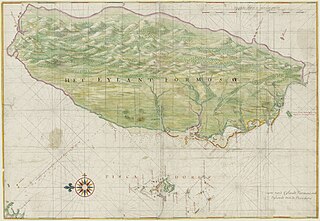
As a result of the surrender and occupation of Japan at the end of World War II, the islands of Taiwan and Penghu were placed under the governance of the Republic of China (ROC), ruled by the Kuomintang (KMT), on 25 October 1945. Following the February 28 massacre in 1947, martial law was declared in 1949 by the Governor of Taiwan, Chen Cheng, and the ROC Ministry of National Defense. Following the end of the Chinese Civil War in 1949, the ROC government retreated from the mainland as the Chinese Communist Party (CCP) proclaimed the establishment of the People's Republic of China. The KMT retreated to Taiwan and declared Taipei the temporary capital of the ROC. For many years, the ROC and PRC each continued to claim in the diplomatic arena to be the sole legitimate government of "China". In 1971, the United Nations expelled the ROC and replaced it with the PRC.
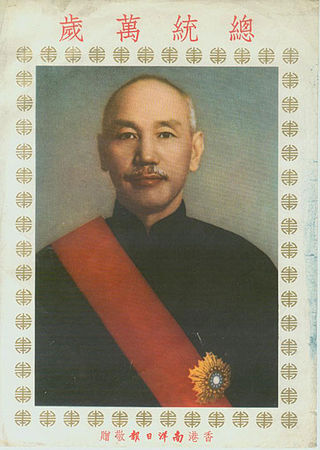
Propaganda in the Republic of China has been an important tool since its inception with the 1911 Revolution for legitimizing the Nationalist government that retreated from mainland China to Taiwan in 1949. Anti-communism and opposition to the Chinese Communist Party have historically been central to propaganda in the Republic of China.

The Nationalist government, officially the National Government of the Republic of China, refers to the government of the Republic of China from 1 July 1925 to 20 May 1948, led by the nationalist Kuomintang (KMT) party.
In the history of political parties in China, the first major party in China was the Kuomintang (KMT), which moved to Taiwan in 1949. It was founded in the Republic of Hawaii on November 24, 1894, before being reorganized at Guangdong Province on August 25, 1912, from a union of several revolutionary groups. The Republic of China was founded by Kuomintang's leader Sun Yat-sen later that year. In 1921, the Chinese Communist Party (CCP) was founded by Chen Duxiu and Li Dazhao in Shanghai as a study society, and an informal political network.

The Kuomintang (KMT) is a Chinese political party that ruled mainland China from 1927 to 1949 prior to its relocation to Taiwan as a result of the Chinese Civil War. The name of the party translates directly as "National People's Party of China" or "Chinese National Party" and was historically referred to as the Chinese Nationalists. The party was initially founded on 23 August 1912, by Sun Yat-sen but dissolved in November 1913. It reformed on October 10, 1919, again led by Sun Yat-sen, and became the ruling party in China. After Sun's death, the party was dominated from 1927 to 1975 by Chiang Kai-shek. After the KMT lost the civil war with the Chinese Communist Party in 1949, the party retreated to Taiwan and remains a major political party of the Republic of China based in Taiwan.
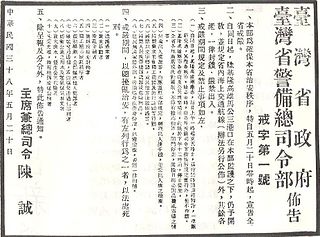
Martial law in Taiwan refers to the periods in the history of Taiwan after World War II, during control by the Republic of China Armed Forces of the Kuomintang-led regime. The term is specifically used to refer to the over 38-year-long consecutive martial law period between 20 May 1949 and 14 July 1987, which was qualified as "the longest imposition of martial law by a regime anywhere in the world" at that time.

The Republic of China (ROC) began on 1 January 1912 as a sovereign state in mainland China following the 1911 Revolution, which overthrew the Manchu-led Qing dynasty and ended China's imperial history. From 1927, the Kuomintang (KMT) reunified the country and ruled it as a one-party state with Nanjing as the national capital. In 1949, the KMT-led government was defeated in the Chinese Civil War and lost control of the mainland to the Chinese Communist Party (CCP). The CCP established the People's Republic of China (PRC) while the ROC was forced to retreat to Taiwan; the ROC retains control over the Taiwan Area, and its political status remains disputed. The ROC is recorded as a founding member of both the League of Nations and the United Nations, and previously held a permanent seat on the United Nations Security Council until 1971, when the PRC took China's seat in the United Nations General Assembly Resolution 2758. It was also a member of the Universal Postal Union and the International Olympic Committee. The ROC claimed 11.4 million km2 (4.4 million sq mi) of territory, and its population of 541 million in 1949 made it the most populous country in the world.

The pro-Republic of China camp, or the pro-Kuomintang camp (親國民黨派), is a political alignment in Hong Kong. It generally pledges allegiance to the Republic of China (ROC) in Taiwan and the Kuomintang.

Following their defeat in the Chinese Civil War, on December 7, 1949, the remnants of the Nationalist government of the Republic of China (ROC), alongside many refugees, retreated to the island of Taiwan (Formosa). The exodus is sometimes called the Great Retreat in Taiwan. The Nationalist Kuomintang party (KMT), its officers, and approximately 2 million ROC troops took part in the retreat, in addition to many civilians and refugees, fleeing the advance of the People's Liberation Army (PLA) of the Chinese Communist Party (CCP). The CCP, who now effectively controlled most of mainland China, spent the subsequent years purging any remnant Nationalist agents in western and southern China, solidifying the rule of the newly established People's Republic of China (PRC).

Palasia Hotel is a hotel in Koror, Palau. It is the tallest building in Palau with 10 floors and a height of around 36m. The building cost $1 million to build and was funded by Taiwan.
Anti-communism in China has a long history. Before the Chinese Communist Revolution, anti-communist policies were implemented by the Kuomintang (KMT) and conservative warlords. Today, anti-communism in mainland China and among overseas Chinese is sometimes associated with protest movements and support for liberal democracy.
















